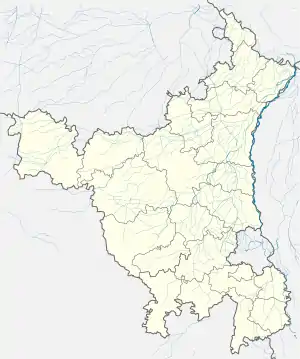Madhogarh Fort, Haryana
Madhogarh Fort is located on top of Madhogarh Hill in the Aravalli mountain range, near Madhogarh village, in the Mahendragarh district of Haryana state in India.[1] It is located 12 kilometres (7.5 mi) from Mahendragarh, reachable via Satnali Chowk or via Mahendragarh- Satnali- Loharu road.
| Madhogarh Fort | |
|---|---|
| Native name Hindi: माधोगढ़ का किला | |
 Location of Madhogarh Fort in Haryana  Madhogarh Fort, Haryana (India) | |
| Location | Madhogarh, Haryana, Haryana, India |
| Coordinates | 28°17′52″N 76°1′59″E |
| Built | first half of 18th century |
| Built for | Madho Singh I |
| Architectural style(s) | Hindu |
| Governing body | Archaeological Survey of India |
In the Madhogarh village, there are several old havelis of interest to tourists, built in the vernacular Hindu architecture in the style of Shekhawato havelis.
History
Madhogarh founded by Madho Singh I in the first half of the 18th century, when he placed the area under the control of Balwant Singh. The fort is named after Madho Singh I; "Madhogarh" literally means "the fort of Madho". Around 1755, this area passed from the Rajputs to the Maratha Empire under Maharaja Khande Rao Holkar of Indore when he attacked the independent Mughal chieftain Ismail Beg, Ismail Beg escaped to Madhogarh and established a post near Madhogarh fort.[2] Khande Rao Holkar attacked Madhogargh fort and captured it on 16 February 1792. Ismail Beg escaped and attacked Kanud when the ruling wife of already deceased Nawab Najaf Quli Khan had died. Khande Rao Holkar then attacked Kanud and captured Ismail Beg, imprisoned him at Agra Fort and put him to death on 1794.[3] Maratha Maharaj Mahadaji Shinde (Scindia) of Gwalior had conquered Rania, Fatehabad and Sirsa from Bhatti Rajput Muslims. Haryana came under Maratha Empire. Mahad Ji divided Haryana in four territories: Delhi (Mughal emperor Shah Alam II, his family and areas surrounding Delhi), Panipat (Karnal, Sonepat, Kurukshetra and Ambala), Hisar (Hisar, Sirsa, Fatehabad, parts of Rohtak), Mewat (Gurugram, Rewari, Narnaul, Mahendragarh). Daulat Rao Scindia ceded Haryana on 30 December 1803 under the Treaty of Surji-Anjangaon to British East India Company's Company rule in India.[4]
Architecture
The fort is one of only a few hill forts in Haryana. The architecture is of Hindu Rajput origin.
It has two portions: an upper section on top of the hill, with a ruined main structure, and a smaller section just below the top of the hill. The fort is surrounded by a high and thick wall around the hill with several bastions. Below the sections of the fort, there is a water tank that still stands. The upper complex has a few chambers that appear to be connected to the water tank.
Conservation and further development
The Government of Haryana plans to develop an integrated tourist resort incorporating the Madhogarh fort.[5][6][7] Both Mahendragarh fort and Madhogarh fort are being restored along the lines of Pinjore Gardens to develop them as the international tourist destination as part of Rewari-Narnaul-Mahendragarh-Madhogarh tourist circuit, and of the INR 100 crore an initial amount of INR 30 crore was already released for the Madhogarh fort in fy2018-19.[8]
In popular culture
Owing to its picturesque location, several movies including Kaun Kitne Paani Mein and Jalpari: The Desert Mermaid were shot here, as was Aditya Narayan's popular Haryanvi song "git pit git pit".
See also
References
- "Gazetteer of Mahandragarh 1988" (PDF). Haryana Revenue Department. Archived from the original (PDF) on 11 November 2014. Retrieved 12 November 2014.
- Ltd, Data & Expo India Pvt; Goyal, Ashutosh (19 October 2015). RBS Visitors Guide India - Rajasthan: Rajasthan Travel guide. Data and Expo India Pvt. Ltd. ISBN 9789380844787.
- Mittal, Satish Chandra (1986). Haryana, a Historical Perspective. Atlantic Publishers & Distri.
- Das, Dr Manas Kumar (1989). INDIAN CULTURAL HERITAGE. Lulu.com. ISBN 9781387044283.
- Haryana to develop new tourist spots
- "Convention facilities to be set up". Archived from the original on 11 November 2014. Retrieved 11 November 2014.
- Haryana govt to give a boost to tourism
- No dearth of fund to develop tourism, UNI India, 8 Dec 2018.